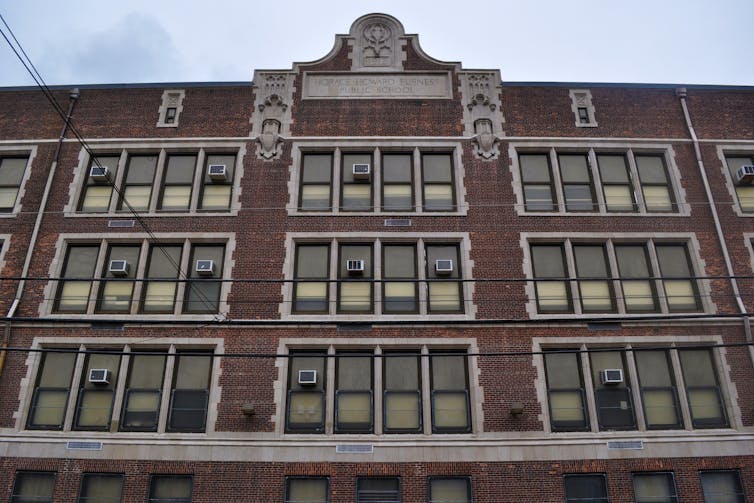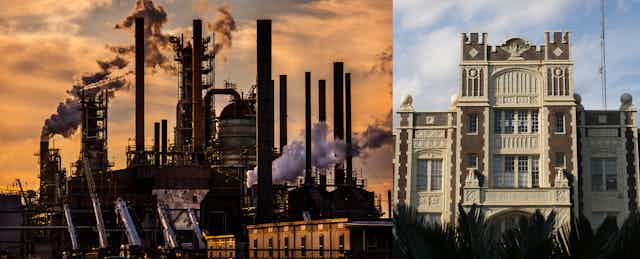At James Elementary in Kansas City, Missouri, principal Marjorie Mayes escorts a visitor to a classroom with exposed brick walls and pipes. Bubbling paint mars some walls, evidence of leaks spreading inside the aging building.
“It’s living history,” Mayes said. “Not the kind of living history we want.”
The district would like to tackle the $400 million in deferred maintenance needed for its 35 schools, but it doesn’t have the money. The lack of funds is a result of tax breaks Kansas City lavishes on companies that do business there. The program is supposed to bring new jobs but instead has starved schools. Between 2017 and 2023, those schools lost $237.3 million through tax abatements.
Property tax drain
That city is hardly an anomaly. An estimated 95% of cities provide incentives to woo corporations. The upshot is billions diverted from urban school districts and from a growing number of suburban and rural districts. The impact is seen in areas as diverse as Chicago, Cleveland, Hillsboro, Oregon, and Storey County, Nevada.
The result? A 2021 review of 2,498 financial statements from schools across 27 states revealed that in 2019 at least $2.4 billion was redirected for tax incentives. Yet that downplays the magnitude: Three-quarters of the 10,370 districts did not provide any information on tax abatement agreements.
Abatements have long been controversial, pitting communities against one another in beggar-thy-neighbor contests. Yet their value is unclear: Studies show most companies would have made the same location decision without subsidies. Meanwhile, schools make up the communities’ largest cost item, meaning they suffer most when companies receive breaks.
A three-month investigation by The Conversation and experts in economic development, tax laws and education policy shows that the cash drain is not equally shared by schools in the same communities. In multiple cities examined, tax abatements often take critical funding from districts that disproportionately serve low-income students from racial minorities.

In Kansas City, for example, nearly $1,700 per student was redirected in 2022 from poorer public schools, while between $500 and $900 was taken from wealthier schools. Other studies found similar demographic trends elsewhere, including New York state, South Carolina and Columbus, Ohio.
The result
The funding gaps often force schools to delay needed maintenance, increase class sizes, lay off teachers or close. All told, tax abatements can harm a community’s value, with funding shortfalls creating a cycle of decline.
Researchers agree that a lack of adequate funding undermines educational outcomes, especially for poor children. A 2016 study found that a 10% increase in per-pupil spending each year for all 12 years results in nearly one-third of a year of more education, 7.7% higher wages and a 3.2% reduction in annual incidence of adult poverty. The study estimated a 21.7% increase could eliminate graduation gaps faced by children from low-income families.
Yet, what locales accomplish with tax abatements is hard to discern. Fewer than a quarter of companies that receive breaks needed an incentive to invest, according to a 2018 study by the Upjohn Institute for Employment Research, a nonprofit research organization.
Perversely, some of the largest beneficiaries are politicians who boast of handing out breaks that inflict so much pain on poorer communities. Governors have used the incentives to take credit for job creation, even when the jobs were coming anyway. “We know that subsidies don’t work,’’ said Elizabeth Marcello, a lecturer at Hunter College. "But they are good political stories.”
In Atlanta, the challenges facing the public schools because of abatements are formidable: The district faces chronic absenteeism among Black students and a teacher shortage. At the same time, Atlanta showers corporations with tax breaks, taking $103.8 million from schools from fiscal 2017 to 2022, according to school system financial statements.
In Philadelphia public schools, asbestos is a major problem, and the district needs $430 million to clean up such environmental hazards. That’s on top of an additional $2.4 billion to fix dilapidated buildings.
Yet money is not available. Matthew Stem, a former district official, testified in a 2023 lawsuit that environmental health risks in schools cannot be addressed until an emergency because “existing funding sources are not sufficient to remediate these types of issues.”
Meanwhile, the city keeps handing out abatements. In fiscal 2022, such breaks cost Philadelphia schools $118 million – more than 25% of the price to remove health dangers. Huge subsets of the community – primarily Black, Brown, poor or a combination – are “drastically impacted” by funding shortfalls, said Kendra Brooks, a City Council member.
A tale of two cities
Baton Rouge is a tale of two cities, with some of the worst outcomes in the state for education, income and mortality, and some of the best outcomes. “It was only separated by sometimes a few blocks,” said Edgar Cage, the lead organizer for the advocacy group Together Baton Rouge. “Underserved kids don’t have a path forward”

A 2019 report from the Urban League of Louisiana found economically disadvantaged students are not provided equitable access to high-quality education. Dawn Collins, a district school board member from 2016 to 2022, said that with more funding, the district could provide targeted interventions for academically struggling students.
The campus of Exxon Mobil, which has received $580 million in tax abatements since 2000, sits not far from schools in desperate need of maintenance. The company received its latest tax exemption, $8.6 million, to install facilities at the Baton Rouge complex that recycle plastic and purify isopropyl alcohol. The project created zero new jobs.
Meanwhile, school bus drivers staged a sickout in protest of low pay and a lack of air-conditioned vehicles. A teacher shortage looms because district pay is so inadequate. Schools have limited internet access, and outside some buildings glass and barbed wire litter playgrounds.
But at least those schools have a playground. Hayden Crockett, a seventh grader at Sherwood Middle Academic Magnet School, told the school board that his sister’s elementary school lacked one.
“If it wasn’t in the budget to fund playground equipment, how can it also be in the budget to give one of the most powerful corporations in the world a tax break?” Crockett said. “The math just ain’t mathing.”
This is a condensed version of an article from The Conversation’s investigative unit. To find out more about the border battle in Kansas City and the back-and-forth between the state of Louisiana and the businesses that line its shores, read the complete version.

